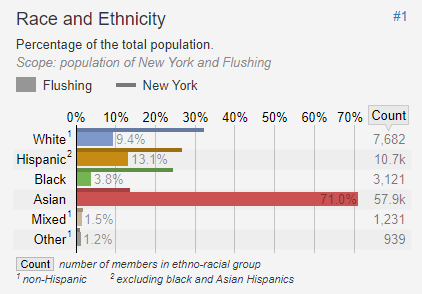Ethnicities among Flushing
Based on data from the 2010 United States Census, the population of Flushing was 72,008, an increase of 2,646 (3.8%) from the 69,362 counted in 2000. Covering an area of 853.06 acres (345.22 ha), the neighborhood had a population density of 84.4 inhabitants per acre (54,000/sq mi; 20,900/km2). The racial makeup of the neighborhood was 9.5% (6,831) White, 4.2% (3,016) African American, 0.1% (74) Native American, 69.2% (49,830) Asian, 0.1% (59) Pacific Islander, 0.2% (172) from other races, and 1.8% (1,303) from two or more races. Hispanic or Latino of any race were 14.9% (10,723) of the population. The entirety of Community Board 7, which comprises Flushing, College Point, and Whitestone, had 263,039 inhabitants as of NYC Health's 2018 Community Health Profile, with an average life expectancy of 84.3 years.This is longer than the median life expectancy of 81.2 for all New York City neighborhoods. Most inhabitants are middle-aged and elderly: 22% are between the ages of between 25 and 44, 30% between 45 and 64, and 18% over 65. The ratio of youth and college-aged residents was lower, at 17% and 7%, respectively. As of 2017, the median household income in Community Board 7 was $51,284. In 2018, an estimated 25% of Flushing and Whitestone residents lived in poverty, compared to 19% in all of Queens and 20% in all of New York City. One in seventeen residents (6%) were unemployed, compared to 8% in Queens and 9% in New York City. Rent burden, or the percentage of residents who have difficulty paying their rent, is 57% in Flushing and Whitestone, higher than the boroughwide and citywide rates of 53% and 51% respectively. Based on this calculation, as of 2018, Flushing and Whitestone are considered to be high-income relative to the rest of the city and not gentrifying.
